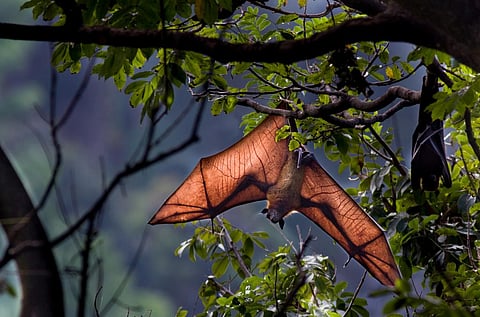

Over 400 bat species are likely to carry undetected betacoronaviruses, according to a paper in Lancet Microbe journal.
Betacoronavirus is one of the four genera of coronaviruses to which SARS-CoV-1 and SARS-CoV-2 belong. The other three are alpha, gamma and delta.
The novel coronavirus disease (COVID-19) pandemic has taught us, among other things, the importance of actively monitoring animals that may host new SARS-like viruses.
Machine Learning (ML), a type of artificial intelligence, can shortlist animal hosts that need further monitoring. ML makes decisions by identifying patterns in data without prior programming.
Evidence suggests that the COVID-19 pandemic emerged when SARS-CoV-2 jumped from a bat species to humans.
There are over 1,400 species of bats. “Artificial intelligence lets us take data on bats and turn it into concrete predictions: Where should we be looking for the next SARS?” the study’s senior author, Colin Carlson, assistant research professor in the Department of Microbiology & Immunology, said.
When the COVID-19 pandemic took off, researchers began detecting viruses in wild bats that were genetically similar to SARS-CoV-2, Daniel Becker, Assistant Professor at the University of Oklahoma and one of the study’s authors, told Down To Earth.
Soon, scientists began training computer models using ML to identify potential hosts of pathogens.
“Many different kinds of models have been applied to predict which species might harbour a particular pathogen. But which models work best,” Becker asked, highlighting the uncertainties around current models.
So, Becker and his colleagues tried to address this question by comparing how eight common predictive models performed on the same task.
Some of the models based their predictions on traits of different bat species such as their ecology, evolution and even the shape of their wings, the researchers said. These are called ‘trait-based’ models.
These models might do a better job at telling which bat species are likely to harbour such viruses, Becker added. The others used data on host-virus interactions to make forecasts.
What did the study find?
In 2020, the team trained all their models using the available data on bat betacoronaviruses. This exercise led them to nearly 370 likely undetected bat hosts of these viruses.
And then, between 2020 and 2021, the team combed for data on newly identified species. After feeding this information, the models identified 47 more bat species likely to carry undetected betacoronaviruses.
“We found that the trait-based models consistently did a better job at correctly identifying these 47 species as betacoronavirus hosts,” Becker said.
Overall, the team predicted that nearly 410 bat species likely carried betacoronaviruses.
There’s more. The researchers also identified hotspots of likely bat hosts of betacoronaviruses. These include the Malay archipelago, equatorial sub-Saharan Africa, Europe and parts of the Americas.
The next step, the researchers said, is disease surveillance. This is already in progress: The team is working with other researchers to test bat samples for coronaviruses.
“If we spend less money, resources and time looking for these viruses, we can put all of those resources into the things that actually save lives down the road,” said Carlson. “We can invest in building universal vaccines to target those viruses or monitoring for spillover in people that live near bats.” It’s a win-win for science and public health, he added.